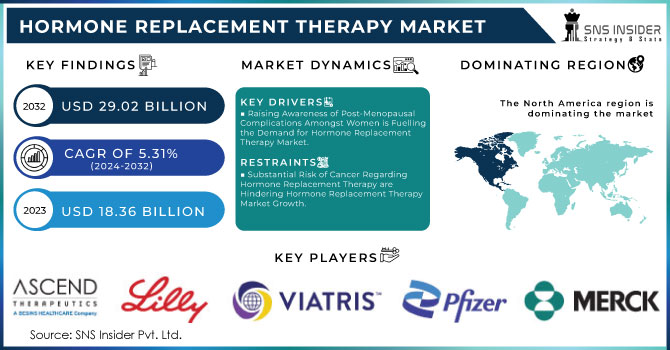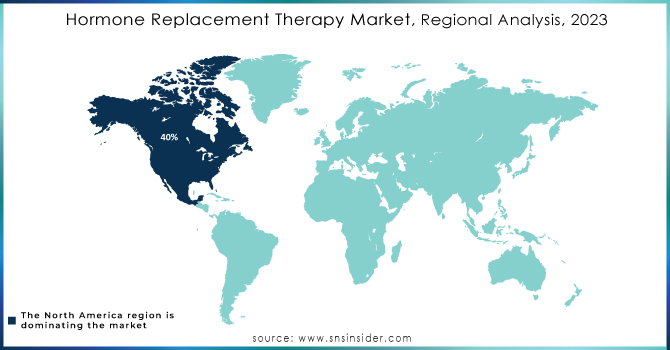Hormone Replacement Therapy Market Report Scope & Overview:

Get More Information on Hormone Replacement Therapy Market - Request Sample Report
The Hormone Replacement Therapy Market Size was valued at USD 18.36 billion in 2023 and is expected to reach USD 29.02 billion by 2032 and grow at a CAGR of 5.31% over the forecast period 2024-2032.
The hormone replacement therapy (HRT) market is expected to increase due to the rising prevalence of post-menopausal Problems, and hormonal imbalance cases along with geriatric population. World Population Prospects 2022 reported that the latest estimates of global population UN projections suggest that there will be nearly 8.5 billion people alive in the year 2021, with the last projection for their number to rise to 9.7 billion by 2050 and then further increase by billion. Most Importantly, characteristics of aging are the natural process that occurs after a certain age in every female with different hormonal changes, and hence disorders start to appear. Many of those issues are weight gain, memory loss, fatigue, and low libido which almost everyone suffers from in that situation as well. Others may develop an aging appearance or even experience slight muscle wasting.
The most commonly experienced effect of age-related hormonal shifts is seen with menopausal cases. The typical age range for the onset of menopause in women is around 50 years globally. Women's estrogen and progesterone production falls significantly with age from around 50 years. According to the North American Menopause Society (NAMS), more than 1.3 million women transition through menopause per year. About nine in every ten postmenopausal women will have experienced at least one symptom of menopause with the most common being hot flushes and night sweats. These hormonal changes are natural with aging and do not represent a disease. Such factors skyrocket the market for hormonal replacement therapy which leads to increasing need and in turn supports the demand for hormone replacement therapy..
KEY DRIVERS:
- Raising Awareness of Post-Menopausal Complications Amongst Women is Fuelling the Demand for Hormone Replacement Therapy Market.
- The Rising Geriatric Population Led to Hormonal Imbalance Disorders Raising the Demand for Hormone Replacement Therapy Which is Boosting Market Growth.
RESTRAINTS:
- Substantial Risk of Cancer Regarding Hormone Replacement Therapy are Hindering Hormone Replacement Therapy Market Growth.
- The Higher Costs of Hormone Replacement Therapy Limit the Adoption of Hormone Replacement Therapy.
OPPORTUNITY:
- Technological Advancements are Offering a Lucrative Growth Opportunity for Hormone Replacement Therapy Systems.
- Investment in R&D is Responsible for the Hormone Replacement Therapy System Market Growth During Upcoming Years.
KEY MARKET SEGMENTATION:
By Route of Administration
- Oral
- Parenteral
- Transdermal
- Others
Based on route of administration, High prescription rate and ease of administration led the oral segment to hold a major market share accounting for 43.06% in 2023. It is most commonly given in the form of hormonal replacement therapy pills & tablets itself. Additionally, the introduction of a new long-acting growth hormone injection is expected to further parenteral segment expansion. Now, a couple of examples in our industry are Pfizer Inc. and OPKO Health Inc., which in January 2022 gained approval from the MHLW for NGENLA to treat growth hormone disorder on its way toward commercialization. This product is a weekly injectable long-acting growth hormone. Thus, the aforementioned factors are bolstering the hormone replacement therapy market growth.
By Disease Type
- Menopause
- Hypothyroidism
- Male hypogonadism
- Growth hormone deficiency
- Hypoparathyroidism
Menopause application held the largest market share of 45.03% in 2023 owing to rising geriatric population across the globe. The Women face mood swings, depression, and anxiety brought on by hormonal transition at the end of the reproductive stage; estrogen levels go down. Estrogen hormone replacement therapy is vital to minimize the complications of aging women-related menopause.
As per the research article -Prevalence and risk factors for menopausal symptoms in middle-aged Chinese women: a community-based cross-sectional study, which was published in November 2021; the prevalence of Menopausal Symptoms was found to be (303/3256=9.3%) (293/1227=23.9%), and (405/1881) =21.5%, while in reproductive stage, Menopause transition & postmenopausal stage respectively. An approach also has previously highlighted these trends in an entitled, and February 2021-published article Korea-style Menopausal Women estimated to have a quarter of active post-menopause vision in elderly women today will be nearly half. Postmenopausal women will comprise 59.8% of the female population expanded by age to year 2060. Therefore, menopause during the transition of life requires therapy for symptoms as would a combination treatment with levonorgestrel releasing-intrauterine system oral or percutaneous route, low-dose hormonal contraceptives, along with estrogen-progestogen therapy. Thus, the menopause indication segment is witnessed to achieve significant growth over the forecast period.
By Product
- Estrogen & Progesterone Replacement Therapy
- HGH replacement therapy
- Thyroid hormone replacement therapy
- Testosterone Replacement Therapy
- Parathyroid Hormone Replacement
Regional Analysis :
In 2023, North America dominated the market with a market share of 40%. The rise in the geriatric population is one of the major drivers for hormonal replacement therapy market induction particularly across North America including the U.S. and Canada. Nearly half of post-menopausal women in the United States have used some form of HRT according to the National Institutes of Health. Also, as per the Statpearls 2021 research article, nearly a million US women experience menopause every year. No such "other candidates" emerged to replace conjugated equine estrogens (CEE)/bazedoxifene tablet, the estrogen and selective estrogen receptor modulator combination approved in the U.S. for the treatment of Vasomotor Symptoms (VMS) associated with menopause along with osteoporosis prevention.
According to the American Thyroid Association (ATA), of 2022, over 12% are apt to develop a thyroid disorder in their lifetime, and nearly 20 million Americans have some form of thyroid disease each year. Consequently, the high prevalence of thyroid hormone imbalances in the population across the United States is anticipated to drive the growth of the human replacement therapy market under study.
In June 2022, Astellas Pharma Inc. submitted an NDA for fezolinetant to the USFDA So, an increasing trend in product approvals is also anticipated to propel the hormone replacement therapy market studied in the region. In the end, North America holds a high growth in the market for hormone replacement therapy throughout the forecast period. The high incidence rate of osteoporosis and increased patient awareness levels are expected to be driving factors for the hormone replacement therapy market.

Get Customized Report as per Your Business Requirement - Request For Customized Report
REGIONAL COVERAGE:
- North America
- US
- Canada
- Mexico
- Europe
- Eastern Europe
- Poland
- Romania
- Hungary
- Turkey
- Rest of Eastern Europe
- Western Europe
- Germany
- France
- UK
- Italy
- Spain
- Netherlands
- Switzerland
- Austria
- Rest of Western Europe
- Eastern Europe
- Asia Pacific
- China
- India
- Japan
- South Korea
- Vietnam
- Singapore
- Australia
- Rest of Asia Pacific
- Middle East & Africa
- Middle East
- UAE
- Egypt
- Saudi Arabia
- Qatar
- Rest of Middle East
- Africa
- Nigeria
- South Africa
- Rest of Africa
- Middle East
- Latin America
- Brazil
- Argentina
- Colombia
- Rest of Latin America
Key Players
The key market players include ASCEND Therapeutics US, LLC, Eli Lilly and Company, Viatris, Inc., Pfizer Inc., Bayer AG, Novo Nordisk A/S, Merck & Co., Inc., F. Hoffmann-La Roche Ltd., AbbVie, Inc. & other players. The market is not consolidated and it is a strong innovation-driven industry, there are big players on the global front. Moreover, the leading players are concentrating on expanding their global product portfolio through acquisitions and partnerships with aligned companies. For example, the US FDA in December 2020 approved VistaPharm's Thyquidity (levothyroxine) oral solution for use as replacement therapy for primary (thyroidal), secondary (pituitary), and tertiary hypothyroidism and approval to be used as adjunctive therapy to surgery and radioiodine management in managing thyrotropin-dependent well-differentiated thyroid cancer.
| Report Attributes | Details |
| Market Size in 2023 | US$ 18.36 Billion |
| Market Size by 2032 | US$ 29.02 Billion |
| CAGR | CAGR of 5.31% From 2024 to 2032 |
| Base Year | 2023 |
| Forecast Period | 2024-2032 |
| Historical Data | 2020-2022 |
| Report Scope & Coverage | Market Size, Segments Analysis, Competitive Landscape, Regional Analysis, DROC & SWOT Analysis, Forecast Outlook |
| Key Segments | •By Product (Estrogen & Progesterone Replacement Therapy, HGH replacement therapy, Thyroid hormone replacement therapy, Testosterone Replacement Therapy, Parathyroid Hormone Replacement) •By Route of Administration (Oral, Parenteral, Transdermal, Others) •By Disease Type (Menopause, Hypothyroidism, Male hypogonadism, Growth hormone deficiency, Hypoparathyroidism) |
| Regional Analysis/Coverage | North America (US, Canada, Mexico), Europe (Eastern Europe [Poland, Romania, Hungary, Turkey, Rest of Eastern Europe] Western Europe] Germany, France, UK, Italy, Spain, Netherlands, Switzerland, Austria, Rest of Western Europe]), Asia Pacific (China, India, Japan, South Korea, Vietnam, Singapore, Australia, Rest of Asia Pacific), Middle East & Africa (Middle East [UAE, Egypt, Saudi Arabia, Qatar, Rest of Middle East], Africa [Nigeria, South Africa, Rest of Africa], Latin America (Brazil, Argentina, Colombia, Rest of Latin America) |
| Company Profiles | ASCEND Therapeutics US, LLC, Eli Lilly and Company, Viatris, Inc., Pfizer Inc., Bayer AG, Novo Nordisk A/S, Merck & Co., Inc., F. Hoffmann-La Roche Ltd., AbbVie, Inc. among others |
| Key Drivers | •Raising Awareness of Post-Menopausal Complications Amongst Women is Fuelling the Demand for Hormone Replacement Therapy Market. •The Rising Geriatric Population Led to Hormonal Imbalance Disorders Raising the Demand for Hormone Replacement Therapy Which is Boosting Market Growth. |
| RESTRAINTS | •Substantial Risk of Cancer Regarding Hormone Replacement Therapy are Hindering Hormone Replacement Therapy Market Growth. •The Higher Costs of Hormone Replacement Therapy Limit the Adoption of Hormone Replacement Therapy. |

